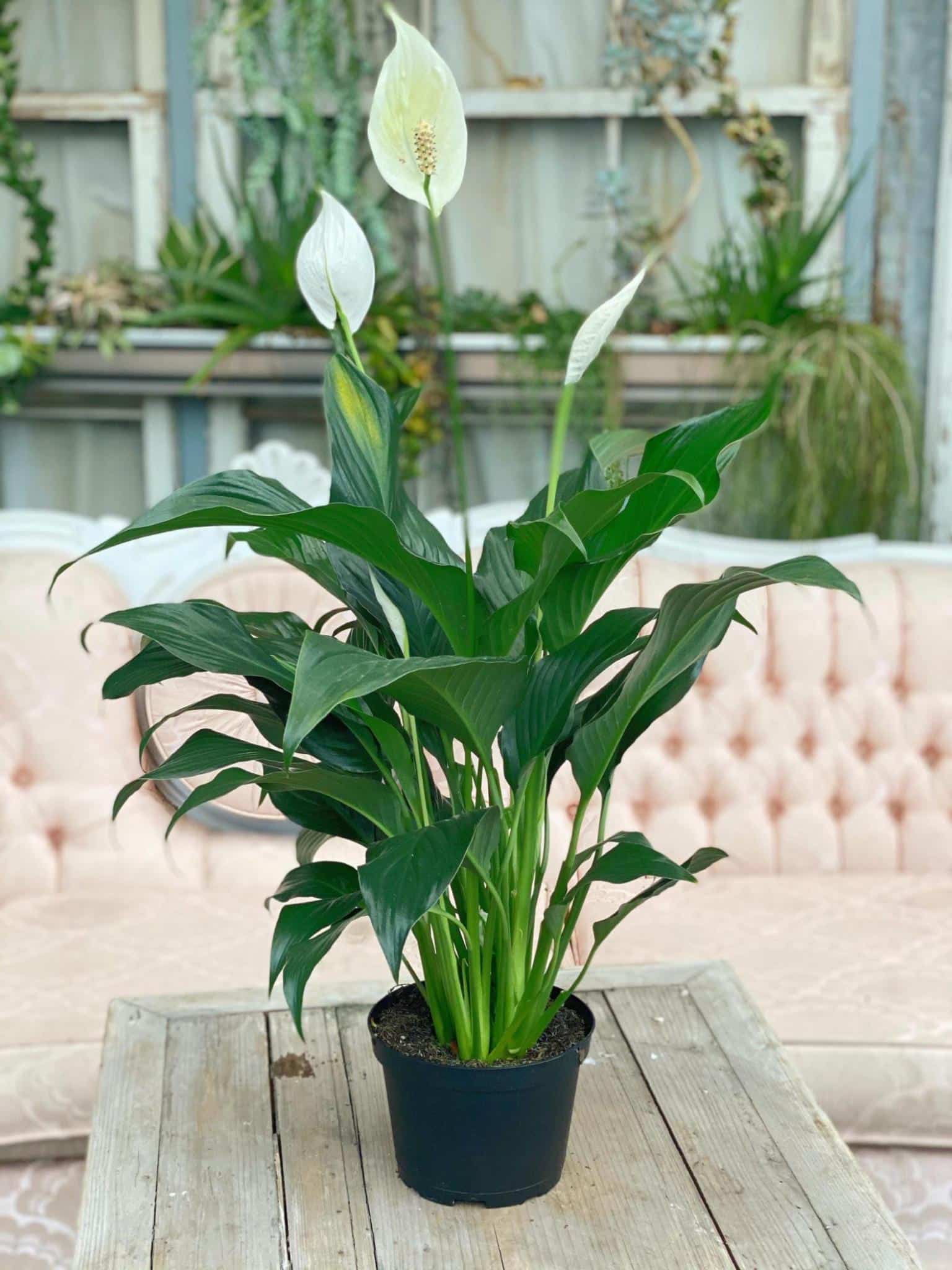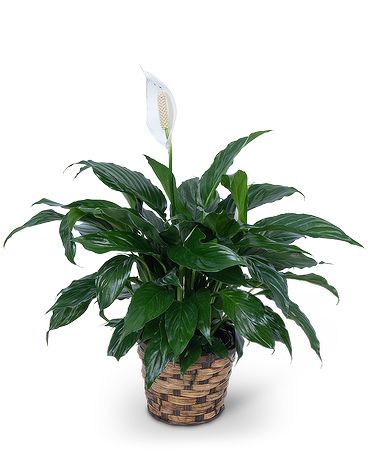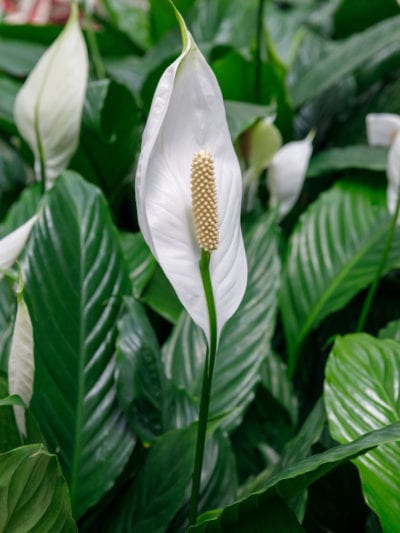Before you look for peace lily root rot issues, know that these plants are among the most well-liked indoor plants in the globe because of their beauty and air-purifying capabilities. Let’s now ascertain the solution.
How are peace lilies with root rot treated? When treating peace lilies for root rot, remove affected roots first to reduce the likelihood of the infection spreading. Overwatering fosters the fungal infection in the peace lily root region and causes rot to occur. Peace lilies are repotted with new soil and water to address this issue. In order to help you better understand the situation with peace lilies, we have covered all of the other problems that root rot can cause in this post.
After the root rot, plants have a harder time growing. By following the instructions provided to rescue your peace lily root rot plant, you can solve this issue. Let’s learn more about this problem.
Table of Contents
How do you know if a peace lily has root rot?
People are wondering a number of things. How can one determine whether a peace lily has root rot? In general, there are a number of apparent indicators in the peace lily leaves, such as yellowing, browning, sogginess, and wilted foliage. And the root rot issues in the plant are the cause of all these symptoms.
I’ll go over every potential indication of root rot in peace lilies:
Leaf Yellowing
A peace lily’s first warning that something is wrong with its roots are yellow leaves. The color of a healthy leaf is green, however the damaged root rot plant’s leaves will turn yellow. It signals a root rot issue brought on by overwatering in the pot. This can occur occasionally as a result of faulty soil, clogged bottom holes, or insufficient drainage. If this issue arises, you should check your peace lily’s root system very away to see if root rot is the cause. You can read about the straightforward solution to this issue in this article.
Leaves Wilting
In peace lilies, this issue typically arises because of inadequate water, although it can also occur because of overwatering. The cause of droopy leaves is usually too much sun, but if that’s not the case with your peace lily, it was definitely too much irrigation that led to root rot. The soil has poor air circulation when a plant wilts as a result of overwatering, which makes it challenging for the roots of peace lilies to effectively deliver nutrients. Check the root system once more for issues with root rot if wilting persists after a few days.
Leaf Spots
Few infections are responsible for the black spots that develop on leaves; in peace lilies, they may be an indication of root rot. At first, we believed it would soon vanish or that trimming would remove the affected leaves. If that doesn’t work, treat your plant for root rot at home to save it. Pruning leaves removes the black spots, but occasionally a specific solvent is required to make them completely disappear. One of the issues in plants that can kill off the plant life is this one.
Root Browning
Sometimes The roots of the peace lily have become brown, fragile, and squishy when you remove them. This indicates that it has a limited lifespan and is readily broken when pulled. If that is the case, it would be challenging to rescue your peace lily plant. However, if you still have healthy roots, you should cut off the infected ones and let the plant to grow normally. Altering the soil and watering routine will also aid in the plant’s proper recovery. Numerous issues can lead to root rot, which mostly damages plant roots. To solve your situation, we must pull those roots out.
Low Potential to grow
Root rot issues in peace lilies are sometimes caused by a plant losing its typical development pattern as a result of shifting environmental conditions.
Root rot weakens the entire plant and may show symptoms like leaf yellowing and browning. It also affects how food and oxygen are normally delivered to all sections of the plant, which makes it harder for the plant to survive in the long run.
Bad Smell
If your plant has root rot, the soil may smell terrible or foul, which can help us determine whether or not its roots are impacted.
But before that, there are other symptoms like leaf yellowing and browning, which occasionally denotes wilting brought on by first root rot.
By replacing the soil and planting your peace lily in a pot with good drainage, you may quickly resolve this problem. Many succulents can withstand root rot without much of an issue, but peace lilies require extra caution.
Stems are weakening
A plant’s stem may begin to dry out first if it is experiencing root rot. A slender stem might not be able to effectively deliver nutrients and water, which causes yellowing or paleening of the leaves. When plants receive too much water or fertilizer, the stems become weaker. Peace lilies are affected by root rot as a result of this. If you have several peace lilies, you can readily tell which one is unhealthy whereas the one that is flourishing in ideal circumstances is referred to as healthy.
What are major causes of root rot in peace lily?
Your peace lily’s roots may decay for a variety of causes. Sometimes we assume it may be because to over fertilization before realizing it was caused by excessive watering. Similar to that, there are many reasons, and we will talk about them here.
The most frequent causes of root rot are inadequate drainage, bad soil, or overwatering. I’ve detailed more of these causes below.
Bad Draining System
There are instances when everything appears to be in order and you are watering routinely, yet the peace lily still looks to have rotted. This is owing to the possibility that occasionally the drainage hole may be clogged by poor soil, dirt that has solidified at the bottom, or smaller pebbles that are preventing water from draining.
As a result of the excess water, the soil becomes soggy, which may prevent roots from finding air circulation. Low oxygen levels will cause them to begin to deteriorate. You should pay close attention to the soil’s quality and take steps to prevent it from becoming too hard. You should not include any smaller stones, occasionally it is recommended for a few plants so they may provide a decent support but it may lead to more drainage difficulties in pots.
Check the drainage hole to make sure it isn’t getting blocked before you can address this. If it’s obstructed, you should unblock the hole and allow the drain to flow. Some pots require you to drill the hole yourself; in these cases, it is done for the first time when you buy the pot. In order to allow water to drain out for our succulents and many other indoor plants, we also check and clean any clogged holes once a year.
Overwatering
The most common cause of peace lily root rot is overwatering because doing so makes it tough for roots to breathe, which in turn makes it challenging to distribute water to other sections of the plant.
Unless it’s a water-growing houseplant, a peace lily should never be given extra water. The soil must be wet but not drenched. It has an effect on the root system, which causes the leaves to yellow.
Loss of pigmentation, leaf damage, spots, and even plant death will occur if the root is unable to supply nutrients and water.
Too much Fertilizer Usage
A nutritious boost from fertilizer can help your peace lily produce more lush, vibrant green leaves. Root rot results from doing it incorrectly or using too much fertilizer. The soil’s nutrients should constantly be in balance, but if they are given in excess, plants have difficulties growing.
Don’t overfertilize it; instead, follow the instructions in the package or consult the internet for further information. You must understand how fertilizer is used in plants and how much to apply because each fertilizer functions differently.
You can either replace the soil or replant it into a new plant with new soil to solve this problem. This will rescue the plant, but it must be done quickly because if it is not, overfertilizing will burn the leaves.
Poor Air circulation
As you are aware, the majority of issues are related to overwatering and poor air circulation, which means the roots must receive oxygen. The peace lily root rots as a result of the soil’s inability to move air as a result of over watering. You should pay closer attention to when to water; if the soil is dry, water only peace lilies.
No airflow
The soil will take a few days to dry up if the area where the peace lily is planted has no airflow. Watering a plant without first checking to see if the soil is moist will result in sogginess, which could cause a root rot issue. The plant may exhibit signs like leaf tips becoming brown or entire leaves turning yellow if the airflow to the roots is restricted. You should relocate your plant to a space with plenty of airflow so that the pot can dry. The need for more water is a bigger issue than the need for less water, but you should concentrate on the needs of the plants.
Low light
As a houseplant, the peace lily requires sufficient indirect sunlight and shouldn’t be kept in a dimly lit environment. Low light won’t do much for a peace lily and the leaf can get less green. The reason for this is that plants begin to prepare food through photosynthesis as soon as they receive light, but under low light conditions, plants do not fully benefit from this process, which results in dimmer, lighter foliage color. You should put the plant in a good area where it can receive indirect light for 10 to 15 hours in order to avoid slowing down photosynthesis and the growth of the plant.
Low light also causes overwatering, which might bring bugs into our home. To help it recover from the low light levels, you should put your peace lily plant in a good spot with indirect light.
Incorrect Pot Size
Small peace lily pots allow water to remain on the soil for longer, which promotes root rot.
If the pot is huge then it requires more water to get moist. Larger pots will take too long to dry, which could cause root rot and a fungus infection in peace lilies.
Too Cold Temperature
Your peace lily may suffer if you reside in a region with a colder environment because, being tropical plants, they require warm climates. They require a warmer atmosphere because they cannot grow adequately in cold climates.
Additionally, this could attract a variety of pests that could harm the plant. Your pot soil may suffer a direct blow to the roots because a cold environment won’t dry it out. Root rot issues may arise if your plant is overly stressed.
Can a peace lily with root rot be saved?
The most practical technique to prevent root rot on a peace lily plant is to cut off the affected roots. If root rot is more severe because of overwatering, you may also need to modify the soil. Use a fungicide liquid solution to prevent any future fungal infections that can easily happen to a region that has root rot problems if the number of rotten roots is low and the others appear healthy. The remedy will clean the soil of all internal and external infections.
Repotting your peace lily right away into a new pot with brand-new soil is another option to keep it. This will get rid of the contaminated dirt, but you also need to cut off the rotting, infected roots.
Due to a fungal infection and a break in the flow of food and water to other sections of the plant, it is impossible for your plant to live if it is 90% rotting. The plant may also not survive for very long. In this situation, you can either propagate it or just purchase a peace lily plant at a nursery or online.
Shop on Amazon for the best fungicide for peace lilies.
How do you treat Peace lilies with root rot?
What do unhealthy peace lily roots look like?
An sick peace lily root may appear brown or black, smell unpleasant, and be wet. Using a sterile pruner, you can trim the roots of the peace lily. A peace lily that appears to have yellow or wilted leaves from the exterior indicates that there is a problem with the roots. When roots rot, the rotting spreads to the leaf area and causes symptoms like wilting, which is a sign that your peace lily has a root rot issue.
by entirely replacing the dirt in the pot, you can treat these problematic roots. Your peace lily plant will undoubtedly live a long life once more if the damaged roots are removed, the healthy roots are washed once more, and the healthy roots are sterilized with fungicide solution.
How do you save peace lily with root rot : Step By Step
Cutting out the diseased roots and replacing the unhealthy soil with new soil is the most efficient technique to treat root rot in peace lilies. Your peace lily most likely has a root rot issue if it appears to be wilting or has yellow leaves.
A Spathiphyllum can decay since it lives in a warm climate and needs to be properly watered and cared for. Let’s now learn the steps for treating peace lily root rot:
How can you tell if a plant has been saved? It’s easy to tell since the plant starts to grow greener and healthier again and the growth on the leaves has returned. Therefore, the root rot issue has been properly resolved.
Fungicide for peace lily
Fungicide is used on peace lilies because root rot problems generate fungal infections, so we use a potent fungicide to stop the fungus from growing and causing the infection to spread.
Triflumizole or thiophanate-methyl can be found in fungicides that work well on peace lilies. This liquid treatment for fungal infections is very effective in eradicating any fungus issue in plants.
Amazon has the best fungicide for peace lilies.
Peace lily pests and diseases
Pests like mealybugs and spider mites can affect peace lilies. Cylindrocladium Root Rot, Leaf Blight, Dasheen Mosaic Virus, and Pythium Root Rot and Scale are diseases that affect peace lilies. Pests can be controlled using a pesticide solution, whilst diseases can be treated with an insecticide or fungicide.
Amazon has the best combined insecticide and fungicide.
Aerial blight peace lily
Other than chopping off the entire leaf, there is no remedy for this aerial blight. Try moving your peace lily plant and monitoring its growth after removing the diseased leaf. If it grows flawlessly, you have found the solution; otherwise, you must adopt an alternative strategy.
Purchase Peace Lily through Amazon
Wrap Up
I sincerely hope you now have the solution to “Peace Lily Root Rot,” and if you’d want to read more of these kinds of articles, see below.
6 Jade Plant Issues and Solutions (Root Rot, Limp)
Problems with the prayer plant: Yellow Leaves and Brown Tips (How to Fix)



